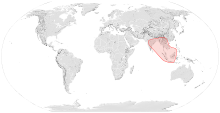Apis andreniformis
| Apis andreniformis | |
|---|---|
| Scientific classification | |
| Kingdom: | Animalia |
| Phylum: | Arthropoda |
| Class: | Insecta |
| Order: | Hymenoptera |
| Suborder: | Apocrita |
| Family: | Apidae |
| Genus: | Apis |
| Subgenus: | Micrapis |
| Species: | A. andreniformis |
| Binomial name | |
| Apis andreniformis F. Smith, 1858 | |
 | |
| Range of Apis andreniformis | |
Apis andreniformis or the black dwarf honey bee is a species of honey bee whose native habitat is the tropical and subtropical regions of Asia.
A. andreniformis was the fifth honey bee species to be described of the seven known species of Apis, and its biology, geographic distribution, and its specific status was recognized by many authors. However, the actual identity of the species was poorly understood, and only recently has it been diagnostically separated from its sister species Apis florea since there are sites where both A. andreniformis and A. florea live conspecifically. Both species are distributed throughout tropical and subtropical Asia, including Southeast China, India, Burma, Laos, Vietnam, Malaysia, Indonesia (Java and Borneo), and the Philippines (Palawan).
Classification
This species, together with A. florea, possesses the most plesiomorphic traits of all living honeybee species. Separating roughly about the Bartonian (some 40 mya or slightly later) from the other lineages, among themselves they do not seem to have diversified a long time before the Neogene.(Arias & Sheppard 2005)
These two species together comprise the subgenus Micrapis, and are the most primitive of the living species of Apis, reflected in their small colony size, and simple nest construction. The exposed single combs are built on branches of shrubs and small trees. The forager bees do not perform a gravity oriented waggle dance on the vertical face of the comb to recruit nestmates as in the domesticated Apis mellifera and other species. Instead they perform the dance on the horizontal upper surface where the comb wraps around the supporting branch. The dance is a straight run pointing directly to the source of pollen or nectar that the forager has been visiting. In all other Apis species, the comb on which foragers dance is vertical, and the dance is not actually directed towards the food source.
Physical characteristics
The most significant morphological characteristic of the species are black stripes on the legs, specifically on the tibia and on the dorsolateral (back and side) surface of the basitarsus. (See Arthropod leg). Additionally, the pigmentation of A. andreniformis is blackish, while that of A. florea is yellowish. Other distinguishing characteristics include a difference respective cubital indexes: A. andreniformis has an index of 6.37, and A. florea one of 2.86. Also, the proboscis of A. andreniformis has a length of 2.80 mm, while that of A. florea is 3.27 mm. This physical difference contributes to a division in the distribution of naturally occurring nectar between the two species. Finally, there are differences in the barbs of the stinger, and in the basitarsus of the drones.
Ecology
A andreniformis nests in quiet forests, generally in darker areas where there is 25 to 30% of normal sunlight. The hive is usually made in branches of bamboo and banana plants, in shrubs, and in bushes such as coffee and tea. They can be built between 1 to 15 meters from the ground, although the average altitude is 2.5 m. The honeycomb typically ranges from 70 to 90 mm in size.
A. andreniformis is generally more defensive than A. florea: it is known to attack when there are disturbances 3 to 4 meters from the hive.
Queenless A. andreniformis colonies have been observed to merge with A. florea colonies, suggesting worker A. andreniformis are attracted to queen bee pheremones even belonging to other species in the same genera.[1]
Parasites
The main parasites of both A. andreniformis and A. florea belong to genus Euvarroa. However, A. andreniformis is attacked by the species Euvarroa wongsirii, while Euvarroa sinhai preys on A. florea and colonies of Apis mellifera that are imported. The two species of Euvarroa have morphological and biological differences: while E. wongsirii has a triangular body shape and a length of 47 to 54 micrometres, E. sinhai has a more circular shape and a length of 39 to 40 micrometres.
References
- ↑ Wongvilas, S.; S. Deowanish; J. Lim; V. R. D. Xie; O. W. Griffith; B. P. Oldroyd (August 2010). "Interspecific and conspecific colony mergers in the dwarf honey bees Apis andreniformis and A. florea". Insectes Sociaux 57 (3): 251–255. doi:10.1007/s00040-010-0080-7.
- Arias, Maria C. & Sheppard, Walter S. (2005): Phylogenetic relationships of honey bees (Hymenoptera:Apinae:Apini) inferred from nuclear and mitochondrial DNA sequence data. Molecular Phylogenetics and Evolution 37(1): 25–35. doi:10.1016/j.ympev.2005.02.017. Erratum in Molecular Phylogenetics and Evolution 40(1): 315. doi:10.1016/j.ympev.2006.02.002
- Koeniger G., Koeniger N., Mardan M., Otis G.W., Wongsiri S. Comparative anatomy of male genital organs in the genus Apis. Apidologie 23 (1991) 539–552.
- Oldroyd B.P., Rinderer T.E., Wongsiri S. Pollen resource partitioning by Apis dorsata, Apis cerana, Apis andreniformis, and Apis florea in Thailand. J. Apic. Res. 31 (1992) 3–7.
- Rinderer T.E., Oldroyd B.P., Wongsiri S., Sylvester H.A., de Guzman L.I., Potichot S., Sheppard W.S., Buchmann S.L. Time of drone flight in four honey bee species in south-eastern. Thailand. J. Apic. Res. 32 (1993) 28–33.
- Rinderer T.E., Oldroyd B.P., Wongsiri S., Kuang B., Sylvester H.A., de Guzman L.I., Kuang H., Dong X., Zhai W., Comparative nest architecture of the dwarf honey bees. J. Apic Res. 35 (1996): 19–27.
- Wongsiri S., Limbipichai K., Tangkanasing P., Mardan M., Rinderer T.E., Sylvester H.A., Koeniger G., Otis G. Evidence of reproductive isolation confirms that Apis andreniformis (Smith 1858) is a separate species from sympatric Apis florea (Fabricius 1787). Apidologie 22 (1990) 47–52.
- Wongsiri S., Lekprayoon C., Thapa R., Thirakupt K., Rinderer T.E., Sylvester H.A., Oldroyd B.P., Booncham U. Comparative biology of Apis andreniformis and Apis florea in Thailand. Bee World 77 (1996) 24–35.